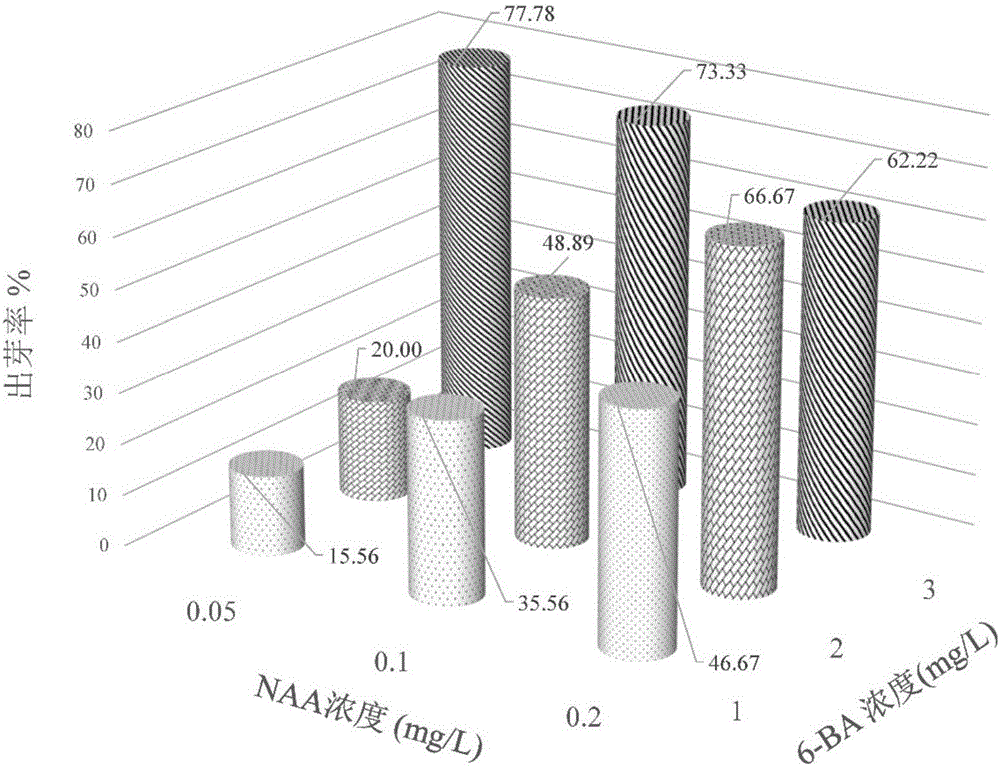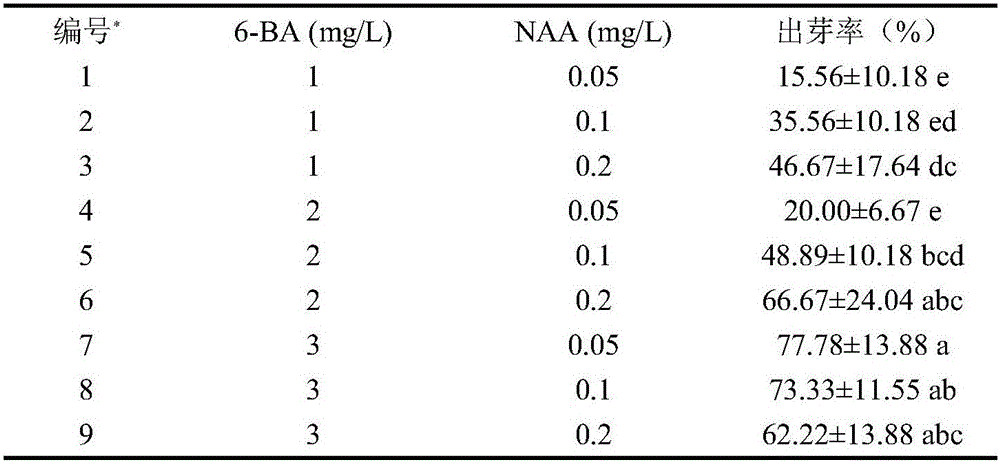Tissue culturing method of physalis angulata
A technology of tissue culture and bitter beetroot, which is applied in the field of plant tissue culture, can solve the problems of slow reproduction speed and low germination rate of bitter beetroot seeds, and achieve the effects of fast reproduction speed, uniform reproductive offspring, and large reproduction coefficient
- Summary
- Abstract
- Description
- Claims
- Application Information
AI Technical Summary
Problems solved by technology
Method used
Image
Examples
Embodiment 1
[0030] The seeds of A. plump were used as experimental materials. The materials were wild provenances from Pujiang, Zhejiang collected by the Zhejiang Provincial Key Laboratory of Germplasm Improvement and Quality Control Technology of Medicinal Plants. They were planted in the experimental field of Xiasha Campus of Hangzhou Normal University, and the mature fruits were taken and peeled off. , wash out the seeds, dry them on silica gel and store them in the refrigerator at 4°C in the laboratory for later use, and cultivate them according to the following steps, such as figure 1 Specific steps are as follows:
[0031] (1) Aseptic germination of seeds: Select seeds with full granules for experiment. The seeds were shaken and soaked in 95% ethanol for 5 min. Then add sodium hypochlorite in 20% alcohol volume and Tween 20 in 0.1% alcohol volume, and continue soaking for 20 minutes. After pouring off the liquid, use sterile ddH 2 O Wash the seeds 3-5 times. Sow the seeds evenly...
Embodiment 2
[0043]The seeds of A. plump were used as test materials. The materials were the wild provenances of Pujiang, Zhejiang collected by the Key Laboratory of Germplasm Improvement and Quality Control Technology of Zhejiang Province. They were planted in the experimental field of Xiasha Campus of Hangzhou Normal University, and the mature fruits were taken and peeled off. , wash out the seeds, dry them on silica gel and store them in the refrigerator at 4°C for later use, and cultivate them according to the following steps, the specific steps are as follows:
[0044] (1) Aseptic germination of seeds: Select seeds with full granules for experiment. The seeds were shaken and soaked in 95% ethanol for 5 min. Then add sodium hypochlorite in 20% alcohol volume and Tween 20 in 0.1% alcohol volume, and continue soaking for 20 minutes. After pouring off the liquid, use sterile ddH 2 O Wash the seeds 3-5 times. Sow the seeds evenly on the glass petri dish containing 1 / 2 MS medium, seal it...
Embodiment 3
[0050] The seeds of A. plump were used as test materials. The materials were the wild provenances of Pujiang, Zhejiang collected by the Key Laboratory of Germplasm Improvement and Quality Control Technology of Zhejiang Province. They were planted in the experimental field of Xiasha Campus of Hangzhou Normal University, and the mature fruits were taken and peeled off. , wash out the seeds, dry them on silica gel and store them in the refrigerator at 4°C for later use, and cultivate them according to the following steps, the specific steps are as follows:
[0051] (1) Aseptic germination of seeds: Select seeds with full granules for experiment. The seeds were shaken and soaked in 95% ethanol for 5 min. Then add sodium hypochlorite in 20% alcohol volume and Tween 20 in 0.1% alcohol volume, and continue soaking for 20 minutes. After pouring off the liquid, use sterile ddH 2 O Wash the seeds 3-5 times. Sow the seeds evenly on the glass petri dish containing 1 / 2 MS medium, seal i...
PUM
 Login to View More
Login to View More Abstract
Description
Claims
Application Information
 Login to View More
Login to View More - R&D
- Intellectual Property
- Life Sciences
- Materials
- Tech Scout
- Unparalleled Data Quality
- Higher Quality Content
- 60% Fewer Hallucinations
Browse by: Latest US Patents, China's latest patents, Technical Efficacy Thesaurus, Application Domain, Technology Topic, Popular Technical Reports.
© 2025 PatSnap. All rights reserved.Legal|Privacy policy|Modern Slavery Act Transparency Statement|Sitemap|About US| Contact US: help@patsnap.com



